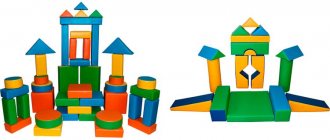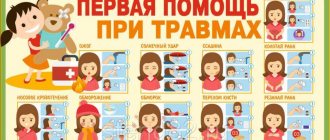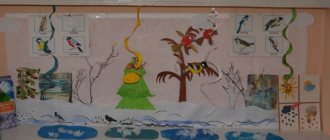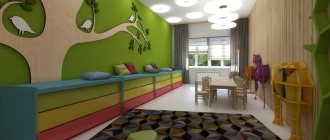The role of corners in children's development
Let's start with the fact that the design of corners in kindergarten is of great importance, especially for children. The child spends most of his time here. And everything fundamental in character, behavior and habits is laid down from a very early age. That is why preschool childhood is an important period in the life of every child. At this stage, he gains experience in social relations, gets to know society, learns to communicate with people, becomes familiar with acceptable forms of behavior and learns to follow them.
For proper and harmonious development, it is important for a child to communicate with peers. This is one of the main reasons why children are sent to kindergarten. Factors such as parents’ employment, the need for adaptation and training, and much more also play an important role.
Children spend a lot of time in kindergarten and their activities there are very diverse: from outdoor games to quiet activities with a teacher. That is why properly organized play areas in kindergarten are of great importance for the development of preschoolers.
The atmosphere in the kindergarten should be such that the child wants to come there. This is especially true for the younger group, because the children have just begun to get used to a new life and a new team, and for the first time they began to be separated from mom and dad for a long time. Everything should help ensure that the process of adaptation to kindergarten is painless. The design of the kindergarten is also of great importance.
The design of a group in kindergarten should not be bright and flashy. Let the light background prevail. Depicting an excessive number of cartoon and fairy-tale characters on the walls is not always justified, especially if these images are large in size. The kid should not be afraid of the huge turtle from the cartoon, which he still does not know at all. It needs to be something educational. For example, the theme of the seasons, because children in the younger group are still very young and are just beginning to learn what snow, rain, and leaves on trees are. The size of the images should not exceed the norm, because the age characteristics of children do not yet allow them to focus their gaze well enough to distinguish large objects.
The knowledge and skills acquired by a child in kindergarten are the basis for his successful education in primary school. Here, teachers unobtrusively, often in a playful way, help the child get acquainted with some school knowledge: numbers, letters, and attend nature and creativity lessons. Classes are held in the form of marathons, competitions, lessons, and holidays. It should also be noted that the child independently studies the information available to him. How can group corners designed by the teacher in kindergarten help?
When thinking about the design of a group in a kindergarten, it would be advisable to divide it into zones. The usual zoning of a group in a kindergarten is: bedroom, dining room, play area and activity area, but additional options can be provided.
There should, of course, be no distracting images where children sleep, as well as in the dining room. But we should talk about developmental zones in kindergarten in more detail.
Zoning in kindergarten
Perhaps, when planning play areas in a preschool educational institution according to the Federal State Educational Standard, one should, first of all, take into account the age of the children and their number. It is also worth finding out the opinion of parents: by asking what they want to see in the group, this will not only show your interest, attention and respect, but also, most likely, you will find proactive helpers.
For convenience, transfer all original ideas for designing a group in a kindergarten to a drawing plan, be sure to indicate on it the names of the corners and their locations.
Depending on the vastness of the space, zoning in a kindergarten group can be quite rich. Below are the most popular zones in the kindergarten group according to the Federal State Educational Standard. Select and organize those that will correspond to your current goals and objectives for the development and upbringing of children.
Zoning in the preparatory group of kindergarten
Outdoor games area
Physical education plays a vital role in the development of children, and it is also important to remember this when planning the design of a kindergarten. Of course, modern kindergartens have gyms and swimming pools, but it is still worthwhile to provide a mini-health corner in the group. This area should be spacious enough. Children should be able to run and jump. A gymnastic wall and various sports equipment would be appropriate here: hoops, balls, skittles, jump ropes. However, we must not forget that the equipment must be appropriate for the age of the children.
Role-playing games area
The design of play areas in a kindergarten provides wide scope for creativity for their organizer. There should, of course, be a lot of toys here. But among their number, children must be able to navigate. Therefore, it is necessary to make themed corners. Separately, you can organize a hairdresser with a chair, dolls and toy tools; hospital, where there will be white coats and medical supplies. You can also create a kitchen corner for girls in kindergarten. To organize it, a toy stove, dishes, food, an apron and a chef's hat, as well as dolls in aprons, are suitable.
Girls, with their favorite games of mother-daughter, tea party or shopping, will feel cozy in a special playhouse. Be sure to post it if possible.
There is also a place for boys in the playhouse; they will be the ones who will come to visit and learn the basics of etiquette. Their play area can be placed nearby and its design can be approached in an equally original way, for example, by making an impromptu garage, where there will be cars of different sizes and purposes: trucks, cars, dump trucks, buses, ambulances, police and fire departments. A railway could also be built here. You can also make a small repair shop corner with toy hammers, nuts, screws and other supplies.
Correctly designing areas in a kindergarten is an excellent opportunity for a teacher to unobtrusively show children the basics of adult life: what and how to cook with, how to properly receive guests, take care of younger children, and much more.
Study area in kindergarten
In the learning corner there must be a table at which several children can be seated at the same time. There they can draw, make crafts, learn to read, count and play relaxing board games.
The filling and design of the learning area in kindergarten should take into account the age of the children. Place here cubes, mosaics, various kinds of construction sets that do not contain small parts, educational and educational board games - here kids can practice, developing fine motor skills and expanding their knowledge about the world around them. Don't forget to allocate space for the simplest geometric shapes, shapes of different colors.
The safety corner can be placed separately or, if group space does not allow, it can be made part of the study area. Post here information about traffic rules, fire safety, and standards of behavior indoors and outdoors.
Social Development Zone
The previous zone can be separated by a bookcase or bookcases, combining with a social development corner and a book corner. It is advisable to locate this area away from the place of noisy games, because, being distracted, the child will not be able to concentrate on communicating with the book. The corner should be well lit and have a place where the baby can sit and leaf through a book.
Through a book, a child learns a whole range of human feelings, thoughts, and relationships between characters. By identifying himself with a hero, a child takes on a certain model of behavior, which he tries to follow throughout his life. It is necessary to provide a corner with various books appropriate to the age category of children. There should be fairy tales, instructive stories, books about nature, as well as educational books. The corner should be regularly replenished with new interesting and colorful specimens, thereby maintaining children’s interest in it.
In the social development zone there is a place not only for books, but also for a small family history of each child. Try inviting parents and children to choose photos for small family albums that they can proudly show to friends when talking about family, important events or travel.
Corner of nature
There is no doubt that designing a corner of nature in a kindergarten is an excellent basis for introducing a child to natural phenomena.
In the younger group, as a rule, the corner of nature is limited to indoor plants, but for children in the older group it will be much more interesting to study the calendar, the change of seasons, natural phenomena, parts of plants and trees.
The theme of the corner of nature deserves special attention. It is much more interesting when the exhibition changes, for example, once a quarter, then such a corner of the group will attract much more attention from the child. As winter approaches, it is useful to fill it with information on caring for birds at this time, for example, display photographs of wintering birds, perhaps build a feeder with children in labor lessons.
Creating a greenhouse is also of no small importance. Using the example of different types of plants, the child will understand that plants are different, that not all have a stem, but they all have roots, and the leaves can be of different shapes. You can add butterflies or dragonflies to your greenhouse, which children can make on their own. And if the pots with plants are labeled, it will be doubly educational. In the summer, a corner of nature can be supplemented with living garden or field plants or flowers, and in the fall with the fruits that nature gave.
The living inhabitants of the natural corner in the kindergarten will deserve special interest among the children. There could be a cage with a hamster or an aquarium with fish, and kids can be taught the basics of caring for animals. Before getting a pet, you must obtain the consent of all parents, be sure to ask adults if their children have allergies, and do not forget about a certificate from a veterinarian.
Preschool institutions, as a rule, do not effectively use the area in front of the kindergarten. Quite rarely, children are involved in landscaping the site, where corners such as vegetable gardens, flower beds, and corners of the garden have been created, which can be used to develop the basics of environmental consciousness in the child.
Music Development Zone
A music corner in kindergarten will help to reveal creative talents and increase the overall level of education. If it is not possible to place children's musical instruments there, limit yourself to pictures and a player.
Patriotic education zone
And in cultivating a love of work and patriotism, a local history corner will be a faithful assistant, in which there will be a place for objects of applied art and folk crafts that are popular in your area. Also, be sure to place symbols and portraits of the heads of state and your region here. This area will be especially decorated with dolls in national costumes, even if they are cut out of paper.
Creative Development Zone
The real decoration and pride of the kindergarten group is the children's creativity corner. The children’s works are not only aesthetic in nature, but also stimulate the child to achieve further success and serve as a clear example of the interaction between the teacher and the child.
Creative corners in the group, as a rule, are limited to an exhibition of children's works and crafts. But this is not the only function they can perform. For example, you can organize educational corners in preschool educational institutions dedicated to the work of various people, for example, famous artists or composers.
It is not necessary to use a small space for a creativity corner. For example, when preparing for the New Year, you can cut out and decorate the entire group with snowflakes: thus, you will get a “children’s creativity room.” And if you decorate the Christmas tree with homemade toys, you will get a “Christmas tree of children’s creativity.”
Children love to do things with their own hands; they always try and are happy with the result, if it also turns out to be satisfactory. And if there is an opportunity to decorate and display works in a different way, then you should not limit yourself to just a corner of creativity.
When forming zones in a preschool educational institution according to the Federal State Educational Standard, remember that the main requirement for the environment and design of a group in a kindergarten is safety. Avoid sharp corners, slippery floors, and ensure that wall shelves or decorative items are securely attached.
Approach space planning and design of activity areas in kindergarten creatively and with love, and you will definitely have a cozy group where both children and their parents will be happy to come every day!
“There is no aspect of upbringing, understood as a whole, that is not influenced by the situation, there is no ability that is not directly dependent on the concrete world immediately surrounding the child...
Anyone who manages to create such an environment will make his work easier to the highest degree.
Among her, the child will live and develop his own self-sufficient life, his spiritual growth will be accomplished from himself, from nature...” E. I. Tikheyeva.
The issue of organizing a subject-developmental environment in preschool education today is particularly relevant. This is due to the introduction of the new Federal State Educational Standard (FSES) to the structure of the basic general education program of preschool education, including requirements for the organization and updating of the subject-development environment of a preschool institution. It is important to correctly approach the issue of creating a subject-developing environment. A developmental subject-spatial environment should be understood as a natural, comfortable environment, rationally organized in space and time, saturated with a variety of objects and gaming materials.
1. Requirements for a developing subject-spatial environment in accordance with the Federal State Educational Standard.
A developing subject-spatial environment ensures maximum realization of the educational potential of the group space.
A developing subject-spatial environment should provide the opportunity for communication in joint activities of children and adults, physical activity of children, as well as opportunities for solitude.
The developing subject-spatial environment should provide:
implementation of various educational programs;
- in the case of organizing inclusive education - the necessary conditions for it;
- taking into account the national, cultural and climatic conditions in which educational activities are carried out; taking into account the age characteristics of children.
A developing subject-spatial environment must be content-rich, transformable, multifunctional, variable, accessible and safe.
- The richness of the environment must correspond to the age capabilities of the children and the content of the Program.
The educational space must be equipped with teaching and educational means (including technical ones), relevant materials, including consumable gaming, sports, health equipment, inventory (in accordance with the specifics of the Program).
The organization of the educational space and the variety of materials, equipment and supplies (in the building and on the site) should ensure:
- playful, educational, research and creative activity of all pupils, experimenting with materials available to children (including sand and water);
- motor activity, including the development of gross and fine motor skills, participation in outdoor games and competitions;
- emotional well-being of children in interaction with the subject-spatial environment;
- The transformability of space implies the possibility
changes in the subject-spatial environment depending on the educational situation, including the changing interests and capabilities of children;
3. Multifunctionality of materials implies:
- the possibility of varied use of various components of the object environment, for example, children's furniture, mats, soft modules, screens, etc.;
- the presence in the Organization or Group of multifunctional (not having a strictly fixed method of use) objects, including natural materials, suitable for use in various types of children's activities (including as substitute objects in children's play).
- Environmental variability suggests:
- the presence in the Organization or Group of various spaces (for play, construction, privacy, etc.), as well as a variety of materials, games, toys and equipment that ensure free choice for children;
- periodic change of play material, the emergence of new objects that stimulate the play, motor, cognitive and research activity of children.
- Availability of the environment assumes:
- accessibility for pupils, including children with disabilities and children with disabilities, of all premises where educational activities are carried out;
- free access for children, including children with disabilities, to games, toys, materials, and aids that provide all basic types of children’s activities;
- serviceability and safety of materials and equipment.
- The safety of the subject-spatial environment presupposes the compliance of all its elements with the requirements for ensuring the reliability and safety of their use.
The organization independently determines the teaching aids, including technical, relevant materials (including consumables), gaming, sports, recreational equipment, inventory necessary for the implementation of the Program.
2. Functions of the educational environment of a preschool educational institution
The basic patterns of upbringing and training of preschool children make it possible to formulate the functions of the educational environment of a preschool educational institution in accordance with the preschool educational institution program.
- The function of stimulating children's activity is based on the goal of offering the child a variety of material for his active participation in various types of activities.
- Information function.
The necessary level of information content of the environment at different stages of the development of the child’s personality is ensured by the variety of topics, the enrichment of the functional properties of its elements, the completeness and diversity of its elements.
- Function of maintaining psychological health.
The environment is the most important factor for a child, influencing his emotional state.
The content of materials and equipment, their placement, and the layout of the premises should evoke positive emotions and make it possible to find a convenient place for both collective (“free space”) and individual (“solitude corner”, etc.) activities.
- The educational function of the environment does not require special decoding. The environment itself is the very center where bonds of cooperation, positive relationships, organized behavior, and caring attitude are born.
- The developmental function of the environment is the leading one. Only then can an environment claim the high title of developmental when it contains material that is feasible for every child, when it provides steps for the very advancement that we are talking about, meaning development. The developmental function of the subject environment requires for its implementation a combination of traditional and new, unusual components, which ensures the continuity of the development of activity from its simple forms to more complex ones.
3. The subject-developmental environment of a preschool educational institution as a condition for the successful socialization of a preschool child.
3.1 The influence of the subject-development environment on the development of the child’s personality.
A properly organized subject-developmental environment in a preschool institution (in a group) provides each child with equal opportunities to acquire certain personality traits and opportunities for his comprehensive development. But not every environment can be developmental.
The space organized for children in an educational institution can be both a powerful stimulus for their development and an obstacle that prevents the manifestation of individual creative abilities.
Targets for completing preschool education are clearly outlined in the educational standard. A child must have initiative and independence in various types of children's activities, the ability to choose an occupation, partners, to generate and implement various plans, be confident in his abilities and open to the outside world. Therefore, the subject-spatial environment that stimulates the child’s communicative, playful, cognitive, physical and other types of activity should be organized depending on the age specifics of his development.
The objective world of childhood is not only a play environment, but also an environment for the development of all specific children’s activities (A.V. Zaporozhets), none of which can fully develop outside the objective organization. A modern kindergarten is a place where a child gains experience of broad emotional and practical interaction with adults and peers in the most significant areas of life for his development. The developmental environment of an educational institution is the source of the development of the child’s subjective experience. Each of its components contributes to the child’s development of experience in mastering the means and methods of cognition and interaction with the outside world, the experience of the emergence of motives for new types of activities, and the experience of communicating with adults and peers.
The enriched development of a child’s personality is characterized by the manifestation of direct childish inquisitiveness, curiosity, and individual capabilities; the child’s ability to cognize what he saw, heard (the material and social world) and respond emotionally to various phenomena and events in life; the desire of the individual to creatively display the accumulated experience of perception and cognition in games, communication, drawings, and crafts.
A child’s activity in an enriched developmental environment is stimulated by freedom of choice of activity. The child plays based on his interests and capabilities, the desire for self-affirmation; engages not at the will of an adult, but of his own free will, under the influence of gaming materials that have attracted his attention.
Such an environment contributes to the establishment and affirmation of a sense of self-confidence, and it is this that determines the characteristics of personal development at the stage of preschool childhood.
Developmental education is aimed, first of all, at the development of the child’s personality and is carried out through solving problems based on the transformation of information, which allows the child to show maximum independence and activity; assumes the prospect of a child’s self-development based on cognitive and creative activity.
3.2.Developmental environment as a means of socialization of preschool children
A developmental environment is a system of conditions that ensures the full development of a child’s personality. It includes a number of basic sets necessary for the full physical, cognitive, social, and aesthetic development of younger preschoolers.
The subject environment is created taking into account the age capabilities of children, emerging sexual inclinations and interests and is designed in such a way that the child can find an exciting activity or activity during the day.
Man is a social being, his progress depends not only on biological, but also on social laws. Therefore, it is formed only in the presence of social living conditions.
In the process of interacting with other people, the child gains certain social experience, which becomes an integral part of his personality.
Socialization is the process by which a child learns the behaviors, skills, motives, values, beliefs, and norms of his or her culture.
Most often, the process of socialization is understood as a process of adaptation and accommodation.
Kindergarten is one of the main institutions of socialization, where the teacher organizes the conditions for the successful socialization of the child, covering the development of his behavioral, emotional-sensual, cognitive, existential, moral and interpersonal aspects of his life.
The subject-development environment should not create only external beauty. This is an open, changing, living system, enriched by novelty. The subject-development environment carries with it enormous opportunities to influence the child; it educates and develops him.
In preschool age, the main type of children's activity is play; it is in play that the child trains the social manifestations of his future adult life. He learns to interact with peers, feel them, measure and demonstrate his capabilities, determine his position in relation to the world around him and people. Activities in an enriched environment allow the child to show inquisitiveness, curiosity, explore the world around him without coercion, and strive for a creative reflection of what he has learned.
In a developing environment, the child realizes his right to freedom of choice of activities. He acts based on his interests and capabilities, strives for self-affirmation, engages not at the will of an adult, but at his own request.
This approach to organizing children's activities already contains a mechanism for self-development and self-realization of the growing personality.
For normal mental development, a child must always be in constant and continuous interaction with the social environment.
In role-playing games, children learn social roles, methods of interaction, rules of behavior in society, acquire various socially significant qualities, and also in the process of playing together with peers, the child develops the most important communicative qualities necessary for him in the field of communication and interpersonal interaction.
The subject-spatial world of a kindergarten includes a variety of objects and objects of social reality. Such an environment is necessary for children, first of all, because it performs an informative function in relation to them - each object carries certain information about the world around them and becomes a means of transmitting social experience. The subject-based play environment in a preschool institution meets certain requirements: first of all, this is the freedom of the child to achieve the theme, the plot of the game, certain toys, the place and time of the game.
Ensuring the psychological comfort of the child in an educational institution in order to maintain physical and mental health. In preschool childhood, this condition is an important component of quality education as a whole.
The construction of a subject-development environment by adults should make it possible to organize both joint and independent activities of children aimed at their self-development under the supervision and support of an adult. In this case, the environment performs educational, developmental, nurturing, stimulating, organizational, and communicative functions. But most importantly, it works to develop the child’s independence and initiative.
Enrichment and meaningful integration of the centers of activity of the subject-spatial environment, which has a versatile activation potential, promotes the active inclusion of the child in the educational process, is one of the significant psychophysiological mechanisms for transferring games into educational activities in order to form intellectual, personal, physical qualities, cognitive, social motivation of the child to development, self-realization.
Kindergarten teachers are obliged to create conditions for the emergence and development of play, for the development of communication between children in play, to promote the development of different types of play in children, to create conditions for the development of creative play activity of children, to develop in children, in accordance with their individual capabilities, the ability to self-expression, encourage improvisation through facial expressions, pantomime, expressive movements and intonations, teach children to distinguish between moods, experiences, emotional states of characters and people, conveying them through various gaming means, give children the right to choose gaming means.
— The developing subject-spatial environment is systemic, meets the goals of education and training and the requirements of project culture;
— initiates the child’s activity: its objects, means, goals and methods of achieving them are set by the subject environment;
- takes into account the specifics of the age stages of a child’s development, both leading activities (communication, objective activities, games, and others that arise early and develop towards older preschool age.
In other words, it solves the problem of creating a zone of proximal development through the organization of the subject environment; allows children to interact with each other and with adults;
- along with conservative components, it has frequently changing components that encourage children to learn through practical experimentation with these components, as well as to endow conservative components with new meanings. This gives rise to new ideas, methods, images, which enriches both the children’s activity itself (game, construction, and the development of children in it;
- provides the child with the opportunity to live in a different-scale space, commensurate with the actions of his hands (the “eye-hand” scale), his height and the objective world of adults;
— the developing function of the subject environment combines traditional and new components, which ensures the continuity of the development of activity from its simple forms to more complex and meaningful ones.
The principle of position distance in the interaction between an adult and a child. The group room is conventionally divided into three zones: quiet (study, book corner); medium intensity (theatrical, musical, construction zone); high traffic area (sports corner).
The principle of activity provides the opportunity for joint participation of an adult and a child in creating an environment that can change and be easily transformed. Integration and flexible zoning. The diversity of the subject-based developmental environment is structured according to the types of children's activities, provides children with a choice based on their interests and allows them to engage in interaction with peers or act independently.
Such an organization of space will create an opportunity to realize the right of children to freely choose the type of activity.
It is important that the subject environment has the character of an open, non-closed system, capable of adjustment and development. In other words, the environment is not only developing, but also developing. Under any circumstances, the objective world surrounding the child must be replenished and updated, adapting to new formations of a certain age.
CONCLUSION:
Activities in an enriched environment allow the child to show inquisitiveness, curiosity, explore the world around him without coercion, and strive for a creative representation of what he knows. In a developing environment, the child realizes his right to freedom of choice of activities. He acts based on his interests and capabilities. This approach to organizing children's activities already contains a mechanism for self-development and self-realization of the growing personality.
Thus, when creating a subject-developmental environment, as a condition for the successful socialization of a preschool child, it is necessary to take into account the psychological foundations of constructive interaction between participants in the educational process, the design and ergonomics of the modern preschool environment and the psychological characteristics of the age group at which this environment is aimed.
Literature
- Federal State Educational Standard for Preschool Education (Order No. 1155 of October 17, 2013)
- From birth to school. Approximate general educational program for preschool education / ed. N.E. Veraksy, T.S. Komarova, M.A. Vasilyeva. – 2nd ed. M.: Mozaika-Sintez, 2014
- Glushkova G. Subject-based developmental environment - a means of socialization of a preschooler / l “Preschool education No. 5.2013
- Kavtaradze D.N. Learning and play. Introduction to active learning methods.— M.: Flinta, 1998. 3.
- Tskvitaria T.A. Subject-spatial environment - publishing house "TC Sfera" - 2014








